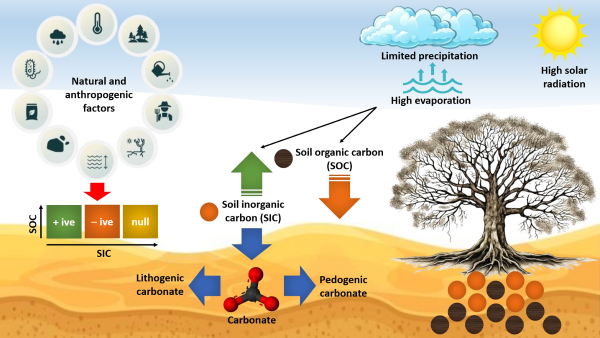Desert Ecosystems Emerge as Frontiers for Carbon Sequestration and Climate Action, New Review Finds
2025-10-29
A recent review published in Biological Reviews has revealed the potential of desert ecosystems in the global fight against climate change. The review, led by Prof. ZENG Fanjiang from the Xinjiang Institute of Ecology and Geography (XIEG) of the Chinese Academy of Sciences, synthesizes evidence showing that deserts can function as vital carbon sinks through innovative management and technology.
The study challenges the traditional view of deserts as barren wastelands. Instead, it presents them as dynamic environments where unique biological and geological processes can capture and store atmospheric carbon dioxide (CO₂).
"Our work fundamentally redefines the role of deserts in the carbon cycle," said Dr. Waqar Islam, the study's first author. "While challenges like water scarcity are real, our synthesis shows that deserts possess a remarkable, and often overlooked, capacity for carbon sequestration through both their soils and specially adapted vegetation."
The review highlights several critical areas. Desert soilsare excellent at preserving carbon over long periods due to slow decomposition. Research in deserts like the Taklimakan demonstrates active microbial processes that convert CO₂ into stable inorganic carbonates, locking carbon away for the long term.
Furthermore, desert plants have evolved efficient strategies to capture and store carbon, even under extreme water stress. Large-scale revegetation efforts in deserts like the Tengger have proven to consistently act as carbon sinks, with soil carbon stocks increasing significantly over time.
The researchers also evaluated a wide range of techniques to enhance carbon capture. These include agroforestry with drought-resistant species, the application of biochar, microbial inoculants to boost soil life, and advanced strategies like the oxalate-carbonate pathway, which uses plants and microbes to form mineral carbonates. Finally, desert regions, with their vast space and suitable geological formations, were identified as ideal locations for Carbon Capture and Storage (CCS) infrastructure, which can permanently store industrial CO₂ emissions underground.
Targeted interventions are key to unlocking this potential. "By implementing sustainable land management, we can combat desertification and enhance the carbon sequestration function of these ecosystems," said Prof. ZENG Fanjiang, corresponding author of the study.
The review has profound implications for regions like Xinjiang, home to vast desert landscapes. By adopting appropriate strategies, these areas can contribute significantly to China's "Dual Carbon" goals (carbon peak and carbon neutrality) while improving ecological health and supporting sustainable development.
Read the full article: https://doi.org/10.1111/brv.70096

Soil carbon cycle in desert environments. (Image by XIEG)
Contact
LONG Huaping
Xinjiang Institute of Ecology and Geography
E-mail: longhp@ms.xjb.ac.cn
Web: http://english.egi.cas.cn



